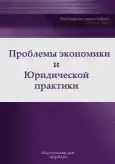Transformation of Human Capital across Regions of Russia
- Authors: Pricina O.S.1, Orekhov V.D.2, Prichina D.Y.1
-
Affiliations:
- Synergy University
- International Institute of Management LINK
- Issue: Vol 18, No 6 (2022)
- Pages: 195-205
- Section: Articles
- URL: https://journals.eco-vector.com/2541-8025/article/view/545925
- ID: 545925
Cite item
Abstract
About the authors
Olga S. Pricina
Synergy University
Email: olgaprichina@mail.ru
Dr. Sci. (Econ.), Professor, Professor of the Faculty of Economics Moscow, Russian Federation
Viktor D. Orekhov
International Institute of Management LINK
Email: vorehov@yandex.ru
Cand. Sci. (Eng.), Director of the scientific and educational center Zhukovsky, Russian Federation
Daria Yu. Prichina
Synergy University
Email: virtualist@mail.ru
Lecturer of the Department of Theory and Methods of Educational Activities, Master of Management, Master of Special defectological Education Moscow, Russian Federation
References
- Orekhov V. D. Forecasting the development of mankind, taking into account the factor of knowledge. Monograph. Zhukovsky: MIM LINK, 2015. -210 p. URL: https://world-evolution.ru/monograph/monography.pdf.
- Arkhangelsky V.N., Ivanova A.E., Rybakovsky L.L. The effectiveness of Russia's demographic policy. M., 2016. p. 14.
- González L. (2013). The effect of a universal child benefit on conceptions, abortions, and early maternal labor supply // Am. Econ. J. Econ. Policy 50 (3): 160-188.
- Cohen A., R. Dehejia, D. Romanov (2013). Financial incentives and fertility // Rev. Econ. Stat. 950 (1): 1-20.
- Milligan K. (2005). Subsidizing the stork: new evidence on tax incentives and fertility // Rev. Econ. Stat. 870 (3): 539-555. URL: https://papers.ssrn.com/sol3/papers.cfm?abstract_id=305071.
- Karpova V.M. Reproductive history as a factor of reproductive behavior. -Vestn. Moscow. un-ta. ser. 18. Sociology and political science. 2018. Vol. 24. No. 3.
- Lewin, K. (1951) Field Theory in Social Science, Harper & Row.
- Foerster, H. von, Mora, P. and Amiot, L. Doomsday: Friday, 13 November, A.D. 2026. Science 132:1291-5. 1960.
- Kapitsa S. P. The phenomenological theory of world population growth. Phys. Usp. 39 57-71 (1996); doi: 10.1070/PU1996v039n01ABEH000127.
- Kosorukova I. V., Kukharenko O.G., Orekhov V.D. et. al. Benefits and drivers of inclusive human capital development. Laplage em Revista (International), vol.7, n. 3B, Sept. -Dec. 2021, p. 337-355.
- A.V. Korotaev, A.S. Malkov, D.A. Khalturina. The mathematical growth model of world population, economy, technologies and education. -Moscow, 2005.
- M.V. Savelieva, V.D. Orekhov. Analysis of the development of Russian regions and their human capital. Moscow Economic Journal. -2022, № 4 doi: 10.55186/2413046X_2022_7_2_225.
- Sorvachev I., Yakovlev E. Could a child subsidy increase long-run fertility and stability of families? Could it have equilibrium effects? Evidence from the «Maternity Capital» program in Russia. -2020. URL: https://papers.ssrn.com/sol3/papers.cfm?abstract_id=3416509.
- Kalabikhina I. E. On regional maternal (family) capital Vestn. Moscow. un-ta. ser. 6. economics. 2013. No. 2, pp. 62-70.
- Polonsky I. Demographic gap in Russia: how to avoid population extinction? Military review. -2019.
Supplementary files








